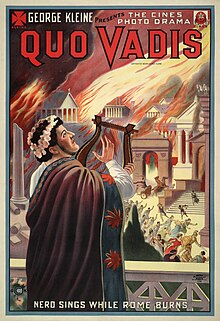Quo Vadis (1913 film)
| Quo Vadis | |
|---|---|
 Film poster | |
| Directed by | Enrico Guazzoni |
| Written by | Enrico Guazzoni |
| Based on | Quo Vadis by Henryk Sienkiewicz |
| Starring | Amleto Novelli Gustavo Serena Carlo Cattaneo Amelia Cattaneo Lea Giunchi Bruto Castellani Augusto Mastripietri Cesare Moltini Olga Brandini Ignazio Lupi Giovanni Gizzi Lia Orlandini Matilde Guillaume Ida Carloni Talli |
| Cinematography | Eugenio Bava Alessandro Bona |
Production company | |
| Distributed by | George Kleine (U.S.) |
Release date |
|
Running time | 120 minutes |
| Country | Italy |
| Language | Silent |

Quo Vadis is an Italian film directed by
, lavish sets, and a lengthy running time of two hours, setting the standard for "superspectacles" for decades to come.A worldwide success, it premiered in Germany at the opening night of the Ufa-Pavillon am Nollendorfplatz (Berlin's first purpose-built, free-standing cinema), on 19 March 1913. In an unusual departure from normal cinematic practice, the crowd scenes were reinforced with "special mobs" of live costumed actors in the auditorium.[4][6]
Quo Vadis was the first film to be projected in the
-
The film
Plot
The story is set during the latter years of the reign of the emperor
Cast
- Amleto Novelli as Vinicius
- Gustavo Serena as Petronius
- Amelia Cattaneo as Eunice
- Carlo Cattaneo as Nero
- Lea Giunchi as Lygia
- Augusto Mastripietri as Chilo
- Cesare Moltini as Tigellinus
- Olga Brandini as Poppaea
- Ignazio Lupi as Aulus
- Giovanni Gizzi as Saint Peter
- Lia Orlandini as servant Livia
- Matilde Guillaume
- Ida Carloni Talli as priestess
- Ursus
- Giuseppe Gambardella

Other versions
- 1901 film directed by Lucien Nonguet and Ferdinand Zecca
- 1924 film directed by Gabriellino D'Annunzio and Georg Jacoby, produced by Arturo Ambrosio
- 1951 film directed by Mervyn LeRoy
- 1985 TV mini-series directed by Franco Rossi
- 2001 film directed by Jerzy Kawalerowicz
- 2002 TV series (6 ep.) directed by Jerzy Kawalerowicz
Removal from U.S. distribution
When the 1924 version was issued, to prevent theatres from showing the 1913 film in competition, the Unione Cinematographica Italiana purchased all rights to the performance of 1913 film in the United States and Australia, including the existing inventory of film prints, stills, posters, and glass slides, from George Kleine, who had obtained the U.S. rights back in 1913.[7]
See also
- Quo Vadis, the novel (1896) by Henryk Sienkiewicz
References
- ISBN 9780810828162.
- ISBN 9788896013045.
- ISBN 978-0-8143-3008-1.
- ^ "Berlin crazy on film shows". New York Times. (Free PDF). 23 March 1913. p. 4c?.
{{cite news}}: CS1 maint: others (link) - ^ Lichtbild-Bühne, Nr. 26, 16 May 1914 (in German) at filmportal.de
- Al. Woods, an international theatre impresario who was also involved in the building of the Nollendorf Theatre in Berlin. The Miracle, with similar crowds of live costumed actors in the auditorium, opened in another Berlin cinema originally leased by Woods, the Ufa-Palast am Zoo, in May 1914.[5]
- ^ "Protect Exhibitors on Showing First National's Quo Vadis". The Moving Picture World. 72 (5). New York City: Chalmers Publishing Co.: 494 31 January 1925. Retrieved 14 August 2021.
Notes
- The Peplum in the days of silent cinema, 1, ch. of "Cinema Peplum" Dominic Cammarota, "Future essays" n. 14, and. Fanucci, '87, p. 15th
- The Dictionary of film Mereghetti-2002-cards, ed. Baldini & Castoldi, 2001, p. 1711.
External links
- Quo Vadis at IMDb
- Synopsis at AllMovie
- Quo Vadis on YouTube
- Post cards with stills at filmstarpostcards.blogspot.com
